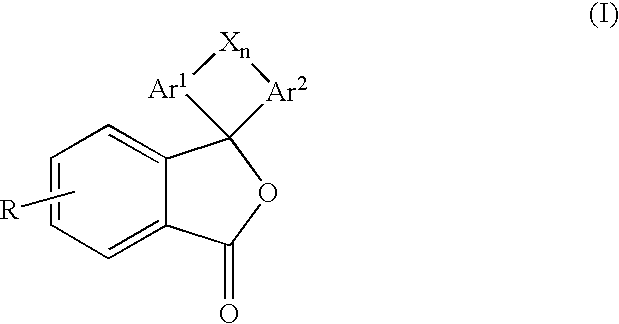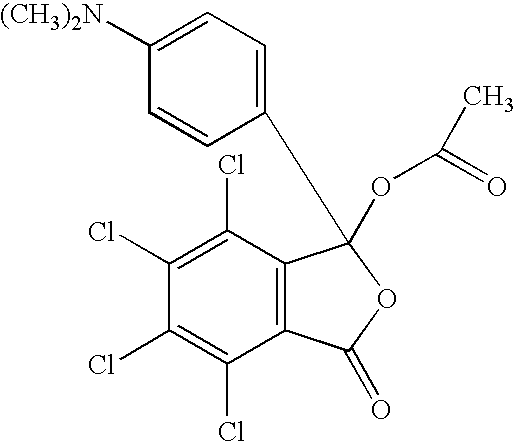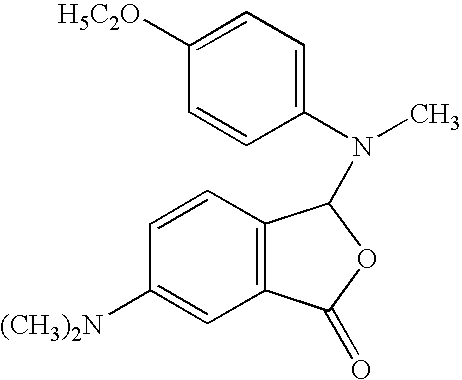Radiation-curable composition with simultaneous color formation during cure
a technology of color formation and composition, applied in the field of optical fiber coating composition, can solve the problems of insufficient solvent-based ink coating, inability to completely satisfy the ink coating, and attenuation of the signal transmission capability of the coated optical fiber, etc., and achieve the effect of improving cure speed and improving curing
- Summary
- Abstract
- Description
- Claims
- Application Information
AI Technical Summary
Benefits of technology
Problems solved by technology
Method used
Image
Examples
examples 1-5
[0193]These Examples illustrate the preparation of substantially colorless fiber optic coating compositions which include a colorless dye precursor system that imparts color to the coating composition upon curing.
[0194]In these examples, the following coating composition was used to evaluate curing and color formation with the five different dye precursors identified below.
[0195]
Wt. %HDDA26.98IBOA28.57PEA31.75Photoinitiator A6.35Photoinitiator B3.18Silicone A1.14Silicone B2.03
The following five different dye precursors were added to the uncured coating composition in an amount of 3 wt.%:
[0196]
Example 1:Copikem 4 blackExample 2:Copikem 34 blackExample 3:Copikem 7 grapeExample 4:Copikem 5 grapeExample 5:Copikem 1 blue
The cationic photoinitiator was GE Silicone UV 9380C, which comprises bis(4-dodecylphenyl) iodonium hexafluoroantimonate, 2-isopropyithioxanthone, C12 and C14 alkyl glycidyl ethers and linear alkylate dodecylbenzene. Each of the compositions of Examples 1- 5 was completel...
example 6
[0199]This Example illustrates the preparation of substantially colorless fiber optic coating composition which includes a colorless dye precursor system that imparts color to the composition upon curing wherein the cationic photoinitiator is a sulfonium cationic photoinitiator.
[0200]In this Example, 94.34% by weight of the base formulation used in Examples 1-5 was mixed with 2.83% by weight of sulfonium cationic initiator commercially available from Union Carbide as UIV 6974 and 2.83% by weight of Copikem 7 grape. The composition was drawn as a film and cured by ultraviolet radiation of 1 J / cm2. The film cured to a deep purple color.
Experiments A-B; Examples 7-8
[0201]These Experiments compare cure rate and cured coating physical properties of colored coatings made with pigments to cure rate and cured coating physical properties with colored coatings made with the colorless dye precursor system in accordance with the present invention. The coatings are suitable as matrix materials.
[...
example 11
[0220]This Example illustrates the preparation of an inner primary coating base with a stabilizer. The formulation for the inner primary coating is set forth in Table II.
[0221]
TABLE IIEx. 11Componentwt %Oligomer E65.00ENPA18.40N-vinylcaprolactam8.00Photoinitiator D1.50Photoinitiator F0.50Photoinitiator A1.50Stabilizer B3.70Stabilizer C0.10Antioxidant A0.20Diethylamine0.10Silicone C1.00Total amount:100.00
[0222]Colored dyes were added to the inner primary coating of Example 11 for aging studies. The Yellow dye used was Neozapon yellow 075, the Red dye was Neozapon red 365, and the Blue dye was Neozapon blue 807. The Neozapon dyes are commercially available from BASF. Aging studies were conducted on the colored coatings to determine color stability of the coatings.
[0223]In the first aging study, the colored coatings were subjected to high intensity fluorescent light, at 5.5 microwatts / cm2 continuously for four weeks. Three tests were carried out in this aging study. In one test, only t...
PUM
 Login to View More
Login to View More Abstract
Description
Claims
Application Information
 Login to View More
Login to View More - R&D
- Intellectual Property
- Life Sciences
- Materials
- Tech Scout
- Unparalleled Data Quality
- Higher Quality Content
- 60% Fewer Hallucinations
Browse by: Latest US Patents, China's latest patents, Technical Efficacy Thesaurus, Application Domain, Technology Topic, Popular Technical Reports.
© 2025 PatSnap. All rights reserved.Legal|Privacy policy|Modern Slavery Act Transparency Statement|Sitemap|About US| Contact US: help@patsnap.com



